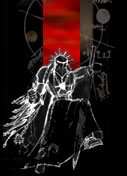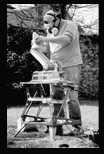

Away from a medieval armoury, Aldeus armours owe more to polyester resins than metal alloys.
Thanks to the first shoot's tight schedule, the original armours were realised in record time. Starting from scratch, a skeleton special effects crew sculpted, moulded, cast, sanded and finalised five complete armours (21 pieces each) in less than 3 weeks. Photos taken during the process are shown below.
Since then, an updated design has been developed, with prototypes made using alternative techniques.





